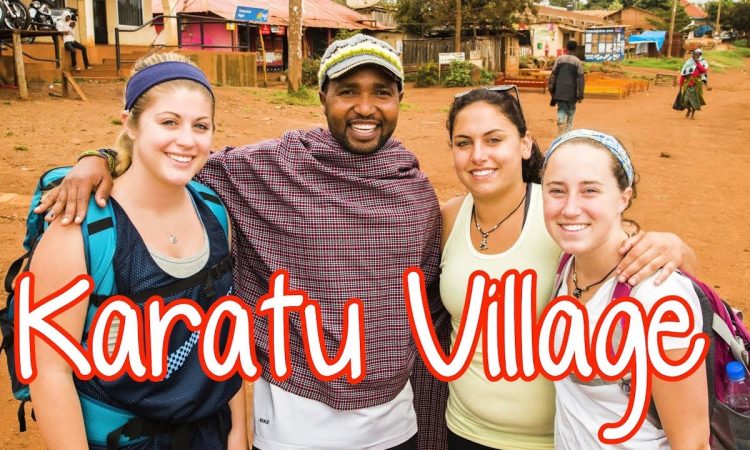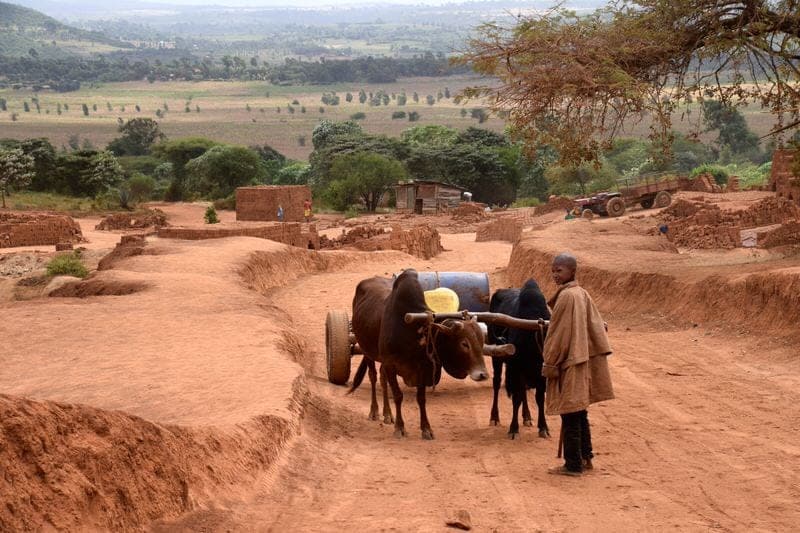Everything To Know About Karatu : Karatu Safari Tour: An Ultimate Guide to Karatu: Arusha District in Tanzania is where the little village of Karatu is located. Karatu, which is situated between Lake Manyara National Park and the Ngorongoro Crater in the northern Tanzania safari circuit, serves as the entrance to the Ngorongoro Highlands. Due to its convenient location, a lot of safari visitors stay overnight or stop by for a quick break, earning it the moniker “Safari Junction.” It is frequently utilized as a brief stopover in between safari excursions or as a less expensive lodging choice than staying inside Lake Manyara National Park, Tarangire National Park and on the rim of the Ngorongoro Crater. However, if you merely consider it a stopover, you can miss out on some incredible outdoor activities and cultural tourism! In order to give yourself a break between safaris, see what Karatu itself has to offer if you have a few extra days.

Maasai herders and oxcarts can be seen traveling alongside safari vehicles, local buses, and brilliantly colored Tuk-tuks in Karatu’s bustling downtown, while just outside the city, well-tended Iraqi farms and villages blend into the lush Ngorongoro Forest’s greenery. You can get the false impression that there is nothing to do in Karatu, Tanzania, if you conduct an Internet search for the best things to do there, Everything To Know About Karatu.
In Karatu, You can explore the town’s marketplace, visit to a nearby brewery, learn about the region’s brickmaking industry, strolled through a coffee farm, go on a guided walk through the Ngorongoro Forest in search of waterfalls and elephant caves, and a visit to an Iraqi homestead in addition to taking in some of the tranquil countryside outside of town.
We believe you should think about stopping in this underappreciated town (Karatu) whether you’re searching for cultural excursions, hiking and biking options, a chance to experience a piece of tranquil rural Tanzania, or simply a respite from the dusty safari game drives.
HOW TO GET TO KARATU
Karatu is easy accessible from Arusha city by a safari vehicle or bus transport. On a good route, it will take slightly over two hours to travel 150 kilometers. Kilimanjaro Airport (JRO), which is roughly 45 minutes from Arusha, serves as the city’s primary international airport, Everything To Know About Karatu.
Taking a bus or dala-dala is a more affordable choice. This may require up to three hours and cost 5,000–7,000 TSH. These are frequently crowded, and because they are so inexpensive, comfort is frequently sacrificed. Generally speaking, it is best to take a bus that arrives before dusk for safety reasons.
A small plane to the Lake Manyara airstrip is also suggested if you want to spend a little more money. On their journeys to the Serengeti, Coastal Aviation and Air Excel both provide flights for about $100 from Arusha to Manyara. In contrast to Kilimanjaro Airport, where you might have arrived by international flight, this flight is likely departing from Arusha Airport, a small local airport. It takes about 30 minutes to get to Karatu from the Manyara airfield, whether you take a cab or a transfer we set up for you.
WHEN TO VISIT KARATU
Despite being a year round safari destination, the dry season, from June to October, is the best time to visit Karatu because it is typically visited in conjunction with or as a base for safaris in the nearby National Parks. Because of the unique geography of the Ngorongoro Crater, it is possible to see animals year-round, but from June to October it is particularly easy to do so because the grass is shorter. This is likewise true for Lake Manyara National Park, despite the fact that both parks are incredibly lush and green during the rainy season. You might find it a little more pleasant in the wet season because, particularly at Ngorongoro Crater, it can get rather busy in the dry season. During the rainy season, some routes may become too muddy and impassable, although this shouldn’t significantly diminish your safari experience, Everything To Know About Karatu.
THINGS TO DO: TOURIST ACTIVITIES IN AND AROUND KARATU
There are quite a lot of attractions in and around Karatu that are worth a visit, despite the fact that it is sometimes merely seen as a crossing between the large safari parks of the Northern Circuit. There are numerous chances for cultural tourism in the bustling town center itself. Why not browse the market for trinkets, tour a coffee plantation, or even attempt home brewing some beer? Along with your hotels, two organizations that focus on cultural tourism in Karatu are best suited to plan activities for you, Everything To Know About Karatu.

The Ganako Cultural Tourism Program arranges eco-friendly excursions in and around Karatu and donates the money earned to a neighborhood nonprofit. Additionally, Iraqw Karatu plans a variety of events that give unique insights into the culture of the nearby tribe. Some of these locations, like the market, can be explored independently, but for the majority of cultural tourism, it is usually ideal to stay on a scheduled trip where a guide can inform you about local customs and guarantee that you interact with the populace appropriately. Here are a few of the tourist activities or things to do in and around Karatu:
Experience the Karatu Market: Every month on the 7th and the 25th, Karatu is visited by local vendors for a large market where you can browse exquisitely crafted goods, pick up some trinkets, and practice your haggling. There is a smaller market on the 25th, but even if none of these dates coincide with your travel plans, there is a smaller market in the town center every day, Everything To Know About Karatu.
Visit a Coffee Farm: Excellent coffee is grown in Tanzania, and the nation’s north is where it is most widely grown. There are several lovely coffee farms available for you to visit or even stay on, where you can discover how to make coffee and sip coffee while taking in the stunning surroundings.
Beer brewing: Ganako may arrange for you to visit a local brewery where you can sample homebrew beer and have a truly Tanzania cultural experience.
Brickmaking: A large portion of the populace in the area makes their living through this craft, which is a significant industry.
Enjoy the local cuisine: whether it is ugali (maize porridge), chips Mayai (fries with eggs), or cassava. You can also partake in a traditional Iraqi supper, which is organized by both Ganako and Iraqw Karatu. To avoid any stomach problems if you decide to do this on your own, just eat cooked food.
Homestays or trips to traditional homesteads are two ways that Ganako and Iraqw can arrange for visitors to learn about local Tanzanian culture and perhaps spend the night with them.
Biking Trips: Around Karatu, there are a lot of paths that are ideal for bicycling.
See how local people and NGOs collaborate to promote more sustainable living in the area by visiting development and eco-initiatives there.
DAY TRIPS FROM KARATU
Karatu is ideal as a base for day trips to nearby sights, in addition to serving as a layover for the major national parks. Ganako and Iraqw Karatu provide day trips to the historic German settlement of Oldeani to learn about the nation’s colonial past and the breathtaking Lake Eyasi, as well as climbs to Mlima Nyoka (Snake Hill) for panoramic views of the surrounding terrain and the Rift Valley. The latter offers undisturbed enjoyment of the lovely lake and its flora and fauna because it is still relatively undiscovered by most people. You can also go hunting with the Hadzabe Bushmen in Lake Eyasi, one of the last groups of hunters and gatherers in East Africa.
IS CULTURAL TOURISM SOCIALLY RESPONSIBLE IN KARATU?
Sometimes, cultural tourism can turn voyeuristic and have overtones of a “slum safari.” You might feel a little uneasy entering people’s homes and lives as a tourist. Both Ganako and Iraqw Karatu guarantee a socially responsible approach to this kind of tourism by assisting neighborhood initiatives and donating money to the areas and people who are visited. Tourism-related businesses play a significant role in these people’s livelihoods. You can learn about cultural customs and taboos by traveling with a guide who can also translate for you. Be responsible and always get permission before taking pictures! Avoid working on initiatives involving children since the constant arrival and departure of volunteers might cause problems for kids who have been abandoned, Everything To Know About Karatu.
LOCAL TRIBES IN KARATU
The Iraqw, a predominately Christian tribe, are the majority group in Karatu. Their language has distinct linguistic characteristics due to its Ethiopian origins. They are farmers who gain from the sale of local crafts like pottery to visitors to the Ngorongoro region.
One of the few groups of hunters and gatherers left in East Africa are the Hadzabe Bushmen, who inhabit the area around Lake Eyasi. As the Tanzanian government gradually encroaches on their territory, only about 1,000 people still reside in the area surrounding the lake. A trip to the Hadzabe is like traveling through time.
The Datoga are farmers and artisans who also reside near Lake Eyasi. They are renowned as fierce warriors and are best recognized for the spherical tattoos on their faces. Only 5% of them know Swahili, the national tongue of Tanzania, and they are incredibly secluded. Extremely low levels of education and literacy exist. They are thought to have migrated south thousands of years ago, and their language has roots in South Sudanese and Ethiopian languages.
WHERE TO STAY IN KARATU
For a few days, Karatu is the ideal location to explore the nearby national parks and Lake Eyasi and discover more about the regional cultures. Since lodging outside the National Parks can be less expensive, many tourists opt to stay in Karatu. Since lodging in Karatu can be less expensive than in national parks, many visitors choose to do so. However, if you are pressed for time, this will require extra driving each day, which could be physically taxing for you. We advise weighing the benefits of staying in a lodge on the crater’s edge against the time and reduced driving required. For all price ranges, Karatu offers first-rate lodging. Here are some of our top recommendations:
High-end choices: Plantation Lodge and the boutique hotel Oldeani Safari Lodge are undoubtedly more expensive, but the stunning surroundings and colonial-style architecture will ensure that your stay is worthwhile.
Mid-range option: Options with a moderate price tag include the lovely gardens surrounding your cottages at Octagon Lodge and Karatu Simba Lodge.
Stay on a coffee farm for a more memorable experience. Gregg’s Farm and the Shangri-La estate of Kifaru Coffee are two outstanding options for doing so. You can learn about the industry firsthand while relaxing in the peaceful cabins and admiring the breathtaking views. While the Shangri-La estate is significantly more affordable but only has a small number of rooms to offer, Gregg’s Farm is a high-end choice that offers luxury and a spa. Make reservations in advance if you want to stay here.
Conclusion: Despite being a small town and serving as a junction between different safari attractions, the Karatu town should never be overlooked or skipped when visiting the different national parks such as the Lake Manyara, Ngorongoro, and Serengeti national parks since the town has many attractions to see and explore and many safari activities to enjoy and make your safari tour unforgettable. Contact us today at Focus East Africa Tours if you are interested in a safari visit to Karatu town; it is a really nice place to visit and you will undoubtedly have an once-in-a-lifetime experience.


